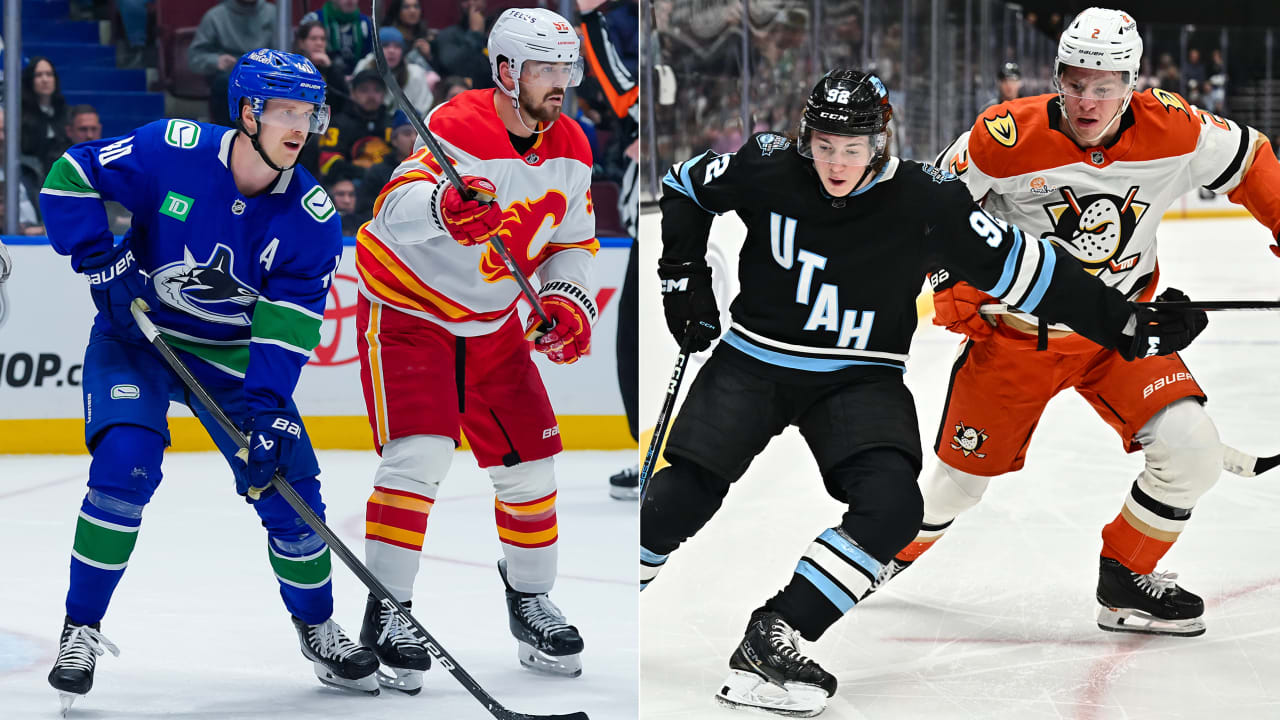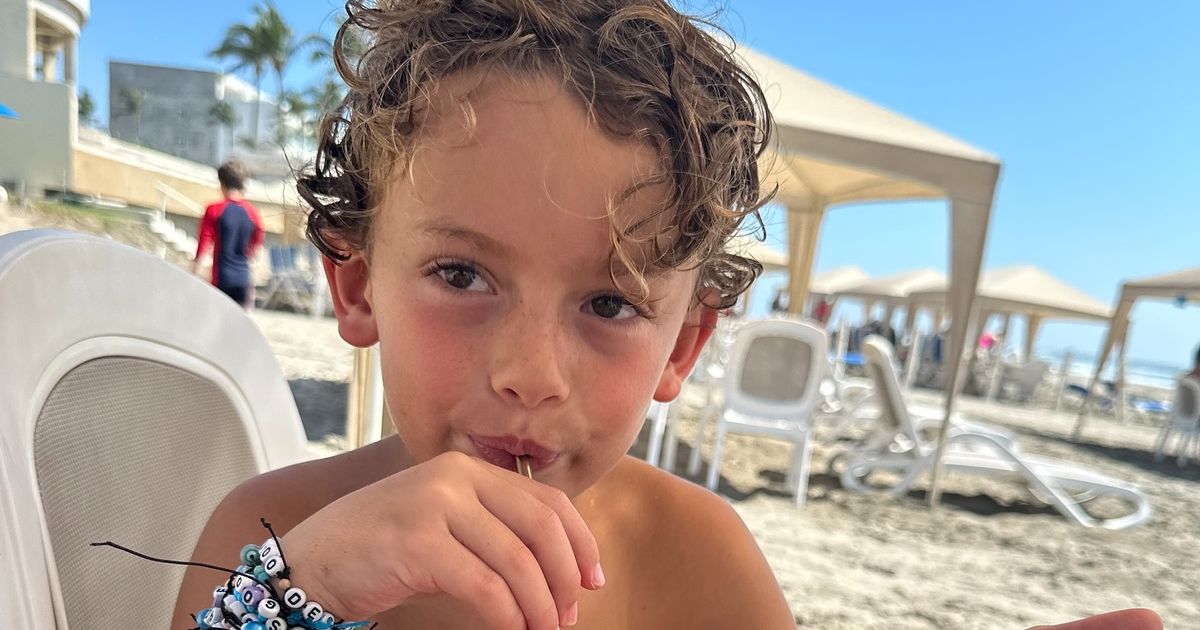
NHL.com continues its preview of the 2025-26 season.
For the eight Western Conference teams that missed the 2025 Stanley Cup Playoffs, their goal since the regular season ended has been determining how to extend their season into June, like the Stanley Cup champion Florida Panthers did.
So how can those teams take the next step? As training camps continue, NHL.com today examines why fans of the eight teams can hold onto their playoff hopes (teams listed in alphabetical order):
ANAHEIM DUCKS
Last season: 35-37-10, 16 points out of second wild card
How it ended: The Ducks had a .507 points percentage (30-29-8) in their final 67 games, but a 5-8-2 start (.400 points percentage) left them too big a hole to climb out of. They were eliminated from playoff contention for the seventh straight season April 3.
Biggest offseason change: Joel Quenneville was hired as coach May 8, returning to the NHL after nearly four years away. He last coached the Florida Panthers, resigning Oct. 27, 2021, one day after being named in an independent investigation into the Chicago Blackhawks for allegations by former player Kyle Beach of sexual assault by then-video coach Brad Aldrich in 2010. Quenneville is second all-time with 969 wins, and he’s one of 12 coaches in NHL history with three Stanley Cup championships, winning with the Blackhawks in 2010, 2013 and 2015. But he’s been out of the game for more than three full seasons, and he’s taking over a team with a young core that last made the Stanley Cup Playoffs in 2018. It’s a situation similar to when Quenneville took over in Chicago four games into the 2008-09 season, inheriting a young team that had been out of the playoffs the previous five seasons. The Ducks clearly are betting on Quenneville’s experience being a difference maker.
Why they could get in: The Ducks have all five of their 20-goal scorers from last season back in the lineup and they added two more in Chris Kreider (trade, New York Rangers) and Mikael Granlund (free agent). Anaheim has an impressive mix of young talent, led by forwards Mason McTavish (age 22), Leo Carlsson (20) and Cutter Gauthier (21), and defensemen Jackson LaCombe (24), Pavel Mintyukov (21), Olen Zellweger (22) and Drew Helleson (24). And they’re supported by dependable veterans in Kreider, Granlund, forward Alex Killorn and defensemen Jacob Trouba and Radko Gudas. Lukas Dostal, who signed a five-year contract July 17, will be the unquestioned No. 1 goalie after John Gibson was traded to the Detroit Red Wings in June. Dostal impressed despite facing 31.9 shots on goal per 60 minutes of ice time, the most in the NHL (minimum 20 games). If the Ducks can be tighter defensively without sacrificing offense, and benefit from Quenneville’s knowledge, it could be enough to get Anaheim into a top-three spot in the Pacific Division.
CALGARY FLAMES
Last season: 41-27-14, missed on regulation wins tiebreaker
How it ended: The Flames won their first two games after play resumed following the 4 Nations Face-Off to put them one point ahead of the Vancouver Canucks for the final wild card in the Western Conference on Feb. 25. But they won just two of their next nine games (2-4-3) to fall two points out of a playoff spot, and never were able to make up that deficit despite finishing the season on an 11-2-3 run. They matched the St. Louis Blues in points for the second wild card but had one fewer regulation win (32-31).
Biggest offseason change: Goalie Ivan Prosvetov (6-foot-5, 195 pounds) signed a one-year contract to back up Dustin Wolf. The 26-year-old had 20 wins, a 2.32 goals-against average and .920 save percentage in 38 games with CSKA Moscow in the Kontinental Hockey League last season. He has NHL experience, playing 24 games during four seasons with the Arizona Coyotes and Colorado Avalanche, most recently in 2023-24. He replaces Dan Vladar, last season’s backup, who had an .898 save percentage in 30 games last season.
Why they could get in: It was a quiet offseason for the Flames, who are banking on a group that finished strong last season being able to carry that over. Wolf was second in voting for the Calder Trophy as NHL rookie of the year and has emerged as a legitimate No. 1 goalie. He also was able to cover for an offense that was 29th in scoring last season, but should get an injection of energy from a full season of rookie defenseman Zayne Parekh. The No. 9 pick of the 2024 NHL Draft scored a goal in his NHL debut April 17 after back-to-back 33-goal seasons with Saginaw of the Ontario Hockey League. It could be a lot to ask for more from Nazem Kadri, who scored 12 goals in his final 16 games to finish with an NHL career-high 35 last season, but will be 35 years old when the season starts. But if he and Jonathan Huberdeau, who looked rejuvenated scoring 28 goals last season at age 32, stay at their high level and talented emerging stars like 22-year-old Matt Coronato (24 goals) and 23-year-old Connor Zary (13 goals in 54 games) can add to the offense, Wolf could provide the backbone for a team capable of contending for a top-three spot in the Pacific or a wild card.
CHICAGO BLACKHAWKS
Last season: 25-46-11, 35 points out of second wild card
How it ended: The Blackhawks won nine of their first 30 games (9-19-2) and were eliminated from playoff contention March 20. It was the fifth straight season they missed the playoffs, tied for the second-longest drought in team history.
Biggest offseason change: The Blackhawks are hoping Andre Burakovsky can provide another secondary source of offense. The 30-year-old forward, acquired in a trade with the Seattle Kraken on June 21, scored 10 goals in 79 games last season, but has four seasons of 17 or more goals, including two with 20, and is a two-time Stanley Cup winner (Washington Capitals, 2018; Colorado Avalanche, 2022).
Why they could get in: The Blackhawks could start the season with as many as eight players age 22 or younger on the roster. Connor Bedard, who has led Chicago in scoring in each of his first two NHL seasons, only turned 20 on July 17 but looks like a player ready to bust out with more support around him. Full seasons from forwards Frank Nazar, 21, who had 26 points (12 goals, 14 assists) in 53 games after being called up from Rockford of the American Hockey League, and Oliver Moore, 20, who had four assists in nine games after signing his entry-level contract March 29, project to bring more young skill. Their youthful enthusiasm also could lead to an uptick in production from veterans like Burakovsky, Tyler Bertuzzi, Teuvo Teravainen and Ryan Donato, who scored an NHL career-best 31 goals. It would be a giant jump at this stage for the Blackhawks to contend for a wild card, but with all the young energy, including defensemen Artyom Levshunov, 19, and Sam Rinzel, 21, and a full season from 24-year-old goalie Spencer Knight, they’ll have a chance to surprise some people.
NASHVILLE PREDATORS
Last season: 30-44-8, 28 points out of second wild card
How it ended: The Predators opened the season on a five-game losing streak, and things didn’t get much better, including losing six of seven (1-6-0) leading into the 4 Nations Face-Off, which left them 18 points out of a postseason spot. They were eliminated from playoff contention March 27.
Biggest offseason change: Despite last season’s struggles, this season’s Predators could look a lot like last season’s team. They got bigger on defense with the additions of Nicolas Hague (6-foot-6, 245 pounds) and Nick Perbix (6-4, 206), and added forward depth with Erik Haula. The biggest change could be larger roles for some of the Predators’ top prospects, among them forwards Joakim Kemell, Fedor Svechkov, Matthew Wood and Brady Martin, the No. 5 pick of the 2025 NHL Draft. Svechkov had 17 points (eight goals, nine assists) in 52 games as a rookie last season and the 22-year-old could open as the second-line center. Kemell had 40 points (19 goals, 21 assists) in 65 games with Milwaukee of the American Hockey League and the 21-year-old made his NHL debut in February. Wood made his NHL debut in April after he tied for second for the University of Minnesota with 39 points (17 goals, 29 assists) in 39 games. And Martin has had a strong training camp, including two goals in his first two preseason games, and could join Wood and Kemell in pushing for top-nine forward spots.
Why they could get in: Almost nothing went right for the Predators last season, but with the talent on their roster it’s tough to predict all those things going wrong again, including goalie Juuse Saros playing better than the NHL career-worst 2.98 goals-against average and .896 save percentage he had in 58 games last season. A forward foundation of Steven Stamkos, Filip Forsberg, Ryan O’Reilly and Jonathan Marchessault is an impressive place to start, and they should get some extra energy from the young players expected to take on larger roles. Most important is the health of defenseman Roman Josi, who is expected back at full strength after receiving treatment for a cardiac issue. As bad as things went in 2024-25 for the Predators, there’s just as good a chance the bounces go their way in 2025-26 and they’re able to compete for a wild card.
SAN JOSE SHARKS
Last season: 20-50-12, 44 points out of second wild card
How it ended: The Sharks lost their first nine games of the season (0-7-2) and never contended for a postseason spot. They were eliminated from contention March 16, their sixth straight season out of the playoffs.
Biggest offseason change: The Sharks acquired goalie Alex Nedeljkovic in a trade with the Pittsburgh Penguins on July 1 to be the experienced half of a goalie tandem with Yaroslav Askarov. Nedeljkovic had a 3.12 goals-against average and .894 save percentage in 38 games last season, slightly off from his career numbers (3.00 GAA, .903 save percentage). Askarov had a 3.10 GAA and .896 save percentage in 13 NHL games last season but is 23 years old and was a standout with San Jose of the AHL, with a 2.45 GAA, .923 save percentage and four shutouts in 22 games. With the Sharks likely envisioning Askarov as their long-term answer in goal, Nedeljkovic’s importance will be in helping Askarov smooth out any bumps in the road.
Why they could get in: The Sharks will continue to lean heavily on their emerging young core of forwards Macklin Celebrini, Will Smith and William Eklund, and added to it with forward Michael Misa, the No. 2 pick of the 2025 NHL Draft who led all Canadian Hockey League players last season with 134 points (62 goals, 72 assists) in 65 games with Saginaw of the Ontario Hockey League. To help them, the Sharks added a few veteran forwards, among them Jeff Skinner, Adam Gaudette and Ryan Reaves. Skinner is a 10-time 20-goal scorer who is just 33 years old and should be able to chip in on a middle-six line, and Gaudette scored an NHL career-best 19 goals with the Ottawa Senators last season. Reaves will supply an element of toughness, leadership and experience. The 38-year-old also should have extra motivation after being put on waivers by the Toronto Maple Leafs last season. Defensemen Dmitry Orlov and John Klingberg also were signed as free agents to add a veteran presence to a group that could include 19-year-old top prospect Sam Dickinson and Shakir Mukhamadullin, 23. If the young players take the next step and the goaltending plays above the .900 5-on-5 save percentage it combined for last season, there’s a chance the Sharks could make a big jump into wild card contention.
SEATTLE KRAKEN
Last season: 35-41-6, 20 points out of second wild card
How it ended: The Kraken were two points out of a playoff spot Dec. 12, but they lost nine of their next 11 (2-8-1) to fall out of postseason contention. They were eliminated March 29, the third time in their four seasons they missed the playoffs.
Biggest offseason change: The Kraken revamped their hockey leadership group during the offseason. Jason Botterill was promoted to general manager, replacing Ron Francis, who was named president, and Lane Lambert was hired as coach, replacing Dan Bylsma. Botterill set out to help the Kraken upgrade a roster that ranked in the bottom half of the NHL in goals-against per game (3.20, 24th), power play (18.9 percent, 23rd) and penalty kill (77.2 percent, 21st). Forward Mason Marchment was acquired in a trade with the Dallas Stars, and defenseman Ryan Lindgren and goalie Matt Murray were signed during free agency.
Why they could get in: Lambert’s specialty is defense; in 2022-23, his one full season as coach of the New York Islanders, they were fifth in the NHL in goals-against per game (2.65) and ninth on the penalty kill (82.2 percent). Lindgren adds more physicality and dependability to a deep defense group that includes Vince Dunn, Brandon Montour, Jamie Oleksiak and Adam Larsson. Finding more offense will be key. Marchment, who scored 22 goals in 62 games last season, will help, as will continued growth from Shane Wright, the No. 4 pick of the 2022 NHL Draft who scored 19 goals in 75 games last season. Wright (21) and Matty Beniers (22) headline a talented young forward group that could get more skilled with the likely addition of Berkly Catton, the No. 8 pick of the 2024 NHL Draft who had 109 points (38 goals, 71 assists) in 57 games with Spokane of the Western Hockey League last season. It’s going to be a crowded field for the Western Conference wild card spots, but with Lambert’s proven ability to coach defense and the young forwards taking a step, there could be room for the Kraken to return to the postseason.
UTAH MAMMOTH
Last season: 38-31-13, seven points out of second wild card
How it ended: The Mammoth went into the Christmas break two points out of a playoff spot but they lost eight of their next 10 (2-7-1), creating too big a deficit to climb out of, despite going 20-12-6 during their final 38 games. Utah was eliminated from playoff contention April 9.
Biggest offseason change: JJ Peterka should add some explosiveness to a Mammoth offense that was tied for 20th in the NHL last season at 2.93 goals per game. The 23-year-old forward, acquired in a trade with the Buffalo Sabres on June 26 for defenseman Michael Kesselring and forward Josh Doan, scored 27 goals in 77 games last season and scored 28 goals in 82 games in 2023-24.
Why they could get in: The biggest question the Mammoth need to answer is can they play a consistent 82 games. In 2023-24, the final season of the Arizona Coyotes before the team’s assets were transferred to the new franchise in Utah, they started 19-14-2 and had the second wild card in the Western Conference on New Year’s Day, but went 17-27-3 the rest of the way and finished 21 points out of a playoff spot. Last season they began 16-15-6 but went 22-16-7 the rest of the way, including 14-8-4 following the 4 Nations Face-Off. Peterka joins an offense that looks ready to bust out with three returning 25-goal scorers aged 27 or under — Clayton Keller (30 goals), Dylan Guenther (27) and Logan Cooley (25). Nate Schmidt was signed to add depth to a defense group that should be better with healthy seasons from John Marino (35 games) and Sean Durzi (30). Karel Vejmelka looked like a workhorse goalie, posting personal NHL bests with 26 wins, a 2.58 goals-against average and .904 save percentage in 58 games. The Central Division arguably is the toughest in the League and beating out the Winnipeg Jets, Dallas Stars and Colorado Avalanche for a top-three spot could be a tough task. But one of the conference’s wild card spots should be within reach.
VANCOUVER CANUCKS
Last season: 38-30-14, six points out of second wild card
How it ended: A loss March 20 knocked the Canucks out of playoff position and started a 4-4-2 run that culminated with them being eliminated from playoff contention April 9.
Biggest offseason change: Adam Foote was hired as coach May 14, two weeks after Rick Tocchet stepped down. Foote joined Tocchet’s staff as an assistant Jan. 22, 2023, and oversaw the defense and penalty kill. Since his arrival Vancouver has allowed 27.9 shots on goal, sixth-fewest in the League, and is 13th on the penalty kill at 80.3 percent. Those numbers were even better last season, when the Canucks were seventh at 26.8 shots allowed per game, and third on the penalty kill at 82.6 percent.
Why they could get in: Off-ice drama and injuries were a reason the Canucks missed the playoffs after winning the Pacific Division in 2023-24, but the hope is those issues have been settled. Forward Elias Pettersson said the knee injury he tried to play through last season has healed, he’s feeling stronger and ready to be more of an impact player and a leader. The 26-year-old still is in his prime and isn’t far removed from the NHL career-best 102 points (39 goals, 63 assists) he had in 80 games in 2022-23. If he’s healthy, there’s no reason he can’t get back to that level. Having Brock Boeser’s contract issues settled after signing a seven-year deal July 1 will help, as should newcomer Evander Kane, the Vancouver native and nine-time 20-goal scorer who was acquired in a trade with the Edmonton Oilers on June 25. Kane is healthy after surgeries for abdominal and knee injuries kept him out during the regular season; he returned with 12 points (six goals, six assists) in 21 Stanley Cup Playoff games to help the Oilers return to the Cup Final. Foote likely will keep the same defensive structure that’s worked the past three seasons, and it could be even better with a full season of defenseman Marcus Pettersson, who arrived in a trade with the Pittsburgh Penguins on Feb. 1. If goalie Thatcher Demko can stay healthy and Kevin Lankinen can have another strong season as his partner, the Canucks have the potential to look closer to the Pacific Division winner from two seasons ago, rather than last season’s playoff miss.



